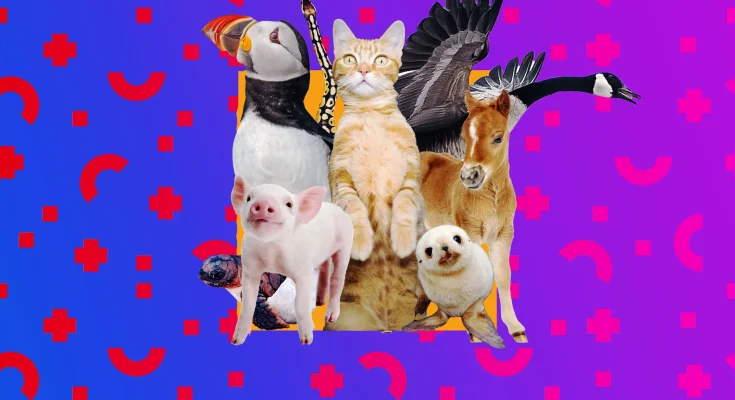Frog is a rooster. Every weekday, he speeds down his family’s dusty driveway, rocking back and forth as he goes, like a feathery wind-up toy. Seconds later, a yellow school bus whines to a halt in front of him, just as Frog knew it would. For the last two years, Frog has never missed his chance to greet Savannah, the family’s teenage daughter, at her bus stop. “He could be indoors and he will start crowing right about the time the bus is gonna come,” says Savannah’s mother, Holley Burns. When Savannah gets off the bus, she carries Frog back to the house—nestled in her arms, settled on her shoulder, perched on the top of her head. “I love him more than my brother,” Savannah says. Don’t believe it? Ask the millions of other people who have watched Frog’s story on YouTube.
Frog likely would have stayed a local legend, a colorful bit of bus route lore, if it hadn’t been for the Dodo, an animal-focused media startup that the Webby Awards crowned the No. 1 animal brand on all of social media this year. To say that their Youtube and Facebook videos often go viral is a wild and hairy understatement
The Dodo racks up around 2.3 billion views each month with heartwarming videos about extraordinary pets (like this super-affectionate python), unlikely interspecies friendships (like this mini horse whose best friend is a goose), and animals in need of adoption by just the right human (like this sick, hairless pupper who became a floofy doggo). They have a separate YouTube channel for kids (Dora the Explorer is a sponsor), a Facebook Watch show about animals overcoming adversity, an Animal Planet show called Dodo Heroes, an IGTV series for teens about influencers and their pets, an upcoming unscripted series for Netflix Kids about an 11-year-old koala activist, and a newly inked children’s book deal with Scholastic. For a company named after a bird that is famously extinct, the Dodo is everywhere.
The Fiddler Crab: One Part Giant Claw, Two Parts Attitude
It didn’t exactly come from nowhere. The Dodo’s founder, Izzie Lerer, is the daughter of Ken Lerer, a well-known media executive and cofounder of The Huffington Post. Her brother, Ben, cofounded Thrillist and now runs Group Nine Media, which in 2016 became the Dodo’s parent company. When Lerer was hatching the idea for what the Dodo would become, she was a PhD student at Columbia University, studying philosophy with an emphasis on animal ethics and human-animal relationships. She launched the website in January 2014 (months before she was due to graduate) with the hope of combining entertainment and animal advocacy, Early on, the Dodo found success as a blog, first going viral with an article about a 103-year-old wild orca whale that put the lie to SeaWorld’s claims that their whales, which frequently die in their 20s, were living to a ripe old age. Then, in 2015, the Dodo made its canniest move to date. Noticing the trend away from blogging and toward mobile and visual entertainment, it pivoted to video.
In the five years since, the Dodo has built up the social media video empire it commands today. On one level, that seems easy. It’s no secret the internet loves animals; that’s been obvious since cats started asking if they can haz cheezburger. In truth, though, the mad craving for creature content resulted in the Dodo’s biggest initial challenge. “We realized that a lot of what was out there was either pure fluff or really heavy and guilt-inducing,” says Dodo president YuJung Kim. “We saw a big white space for something that was entertaining and substantive.” (Lerer, who’s now chief creative officer for the Dodo, was on maternity leave and unavailable for an interview.)
The Dodo’s tone—squeefully sweet but educational, serious in its activism but uplifting—is what has separated it from the slavering hordes of puppy and kitten videography. “The most rewarding thing has been hearing from our audience about how these stories changed their lives,” says Joanna Zelman, the Dodo’s executive producer. “People say they got through chemo by watching the Dodo every day. It’s beautiful.”
Finding these touching stories takes a flock. Many are submitted by the animals’ caretakers or come from organizations and shelters the Dodo has worked with before. For the rest, the Dodo’s 75-person staff scours social media. According to Kim and Zelman, the primary workplace hazard seems to be overflowing with feels; anybody who doesn’t have a pet when they start working at the Dodo acquires a full-time furry friend within their first couple of months. “I didn’t expect to feel so uplifted,” Zelman says. Supposedly, cynicism or banality never set in, even when finding these heartwarming stories is how you pay the bills.
The Dodo does pay the bills, and then some: The company doesn’t share exact sums, but by the reckoning of some online calculators, its YouTube channel alone is worth $18 million. Kim is frank about wanting to optimize shareability and virality. Her favored word for the stories the Dodo tells is—inevitably—“content,” and she describes the cute-but-informative space the Dodo has carved out in the world of animal videos as “an attractive business opportunity.” Her biggest surprise about the Dodo’s success was learning that animals weren’t a niche interest, but “mainstream.” In fact, that’s one of Kim’s primary requirements for members of her staff: “a mainstream love of animals” and social media savvy. Hearing the corporate talk rub up against stories about camera crews sobbing while trying to film newly rescued calves zooming around fields like overgrown puppies can, yes, feel strange—like wandering through the woods and encountering a board meeting.
Of course, that’s also evidence of how good Dodo staffers are at their job, which, like that of all YouTubers, is emotional manipulation: drawing out intense feelings of love and joy and hope just by stitching together animal footage, well-chosen subtitles, and tone-appropriate instrumental music. The suckerpunches to your dopamine center aren’t random, but the result of careful observation and research. “It’s about identifying what makes this animal’s story unique, but also about what makes it relatable to humans,” Zelman says.
And relatability, they’ve found, is often about struggle. One of the Dodo’s most memorable creatures is dwarf pony named Pumpkin, who was born with legs so deformed she was barely able to walk, her ankles giving out beneath her with each step. When Pumpkin was rescued by a sanctuary farm, they wanted to allow her to walk on four hooves, so they started working with prosthetics company Bionic Pets to make custom braces. “It took so many times to get the pony’s prosthetics right,” Zelman says. So many that the Dodo, in its video, considered cutting out some of the failed attempts. The disappointment Pumpkin’s rescuer’s face is awful. “But what people ended up relating to most were the setbacks,” Zelman says. When the prosthetics finally hold Pumpkin’s wobbly legs in place, it’s pure catharsis. All the videos are. It’s hard to avoid doing exactly what you’re supposed to: click, cry salty tears, and share.



